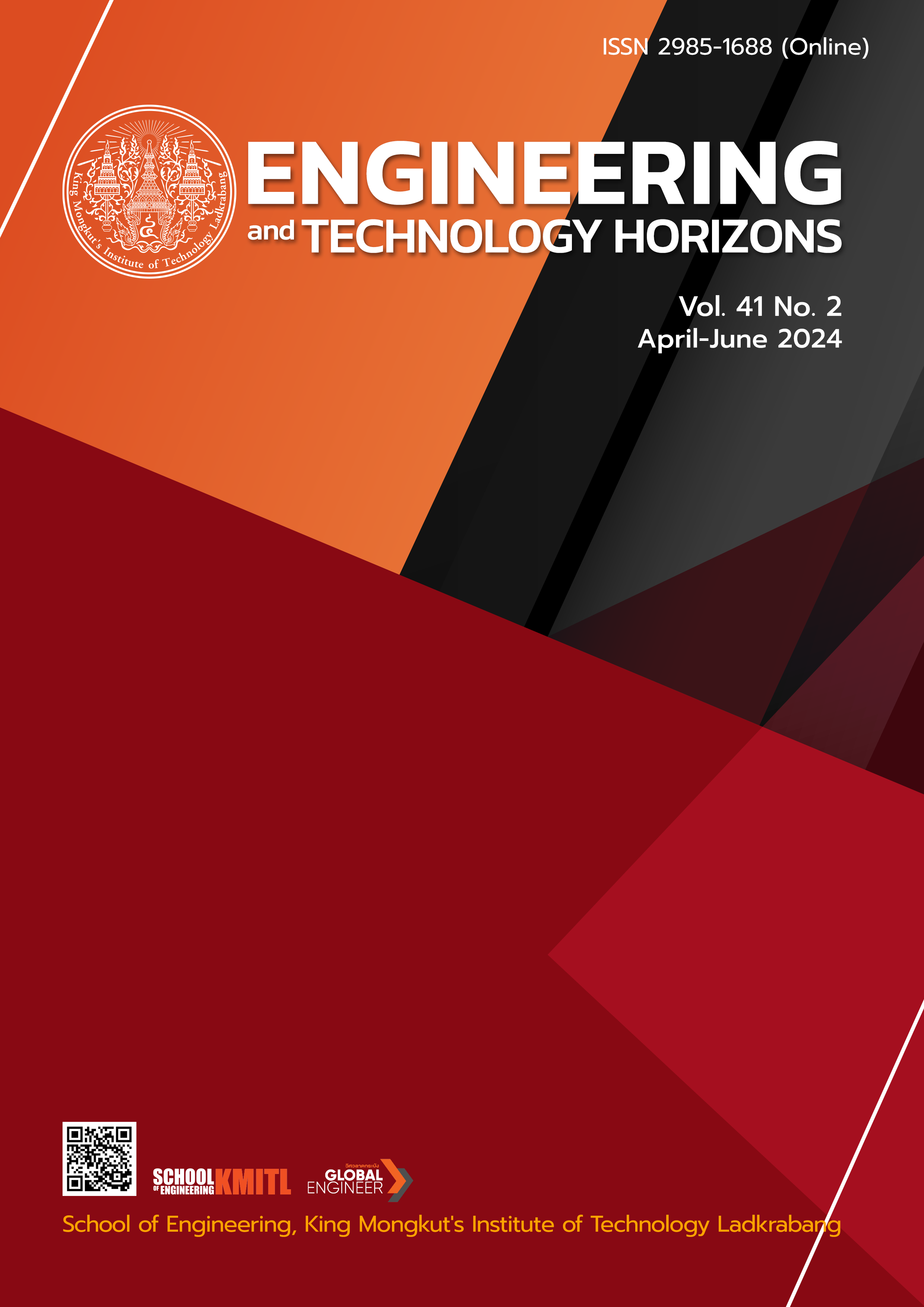Development of Differential Evolution Algorithm for Simple Assembly Line Balancing Problem Type 1
DOI:
https://doi.org/10.55003/ETH.410208Keywords:
Simple Assembly Line Balancing Problem, Differential Evolution Algorithm, HeuristicAbstract
The Simple Assembly Line Balancing Problem Type 1 (SALBP-1) is a widely embraced method in the industry for its simplicity in organizing production processes and enhancing efficiency. Consequently, a Differential Evolution Algorithm (DDE) using a backward task sequence was developed in this study to assist in production process management by determining the optimal number of stations. The efficacy of this method was assessed by juxtaposing it with heuristic approaches, including Longest Operation Time (LOT), Most Following Tasks (MFT), Ranked Positional Weight (RPW), Shortest Operation Time (SOT), Fewest Following Tasks (FFT), Ant Colony Optimization (ACO), Differential Evolution (DE), and Immune Genetic Algorithm (IGA). The findings reveal that DDE outperforms LOT, MFT, RPW, SOT, and FFT in discovering superior solutions and consistently matches solutions achieved by ACO, DE, and IGA methods across all problems. Notably, the DDE method exhibits a shorter time frame for solution discovery.
References
K. Chantarasamai and O. U. Lasunon, “Modified Differential Evolution Algorithm for U-Shaped Assembly Line Balancing Type 2,” International Journal of Intelligent Engineering & Systems, vol. 14, no. 4, pp. 452–462, 2021, doi: 10.22266/ijies2021.0831.39.
J. Dou, J. Li and Q. Lv, “A hybrid particle swarm algorithm for assembly line balancing problem of type 1,” in 2011 IEEE International Conference on Mechatronics and Automation, Beijing, China, 2011, pp. 1664–1669, doi: 10.1109/ICMA.2011.5986373.
M. N. I. Sulaiman, Y. H. Choo and K. E. Chong, “Ant colony optimization with look forward ant in solving assembly line balancing problem,” in 2011 3rd Conference on Data Mining and Optimization (DMO), Putrajaya, Malaysia, 2011, pp. 115–121, doi: 10.1109/DMO.2011.5976514.
Y. guang Zhong and B. Ai, “A modified ant colony optimization algorithm for multi-objective assembly line balancing,” Soft Computing, vol. 21, no. 22, pp. 6881–6894, 2017, doi: 10.1007/s00500-016-2240-9.
A. C. Nearchou and S. L. Omirou, “Assembly Line Balancing Using Differential Evolution Models,” Cybernetics and Systems, vol. 48, no. 5, pp. 436–458, 2017, doi: 10.1080/01969722.2017.1319238.
P. Parawech and R. Pitakaso, “Solving an Assembly Line Balancing Problem by Differential Evolution,” Journal of Industrial Technology Ubon Ratchathani Rajabhat University, vol. 3, no. 6, pp. 13–20, 2013.
P. Parawech, R. Paitakaso and P. Mayachearw, “Solving an Assembly Line Balancing Problem by Differential Evolution: A Case Study of a Garment Factory,” Princess Naradhiwas University Journal, vol. 6, no. 2, pp. 92–104, 2014.
H. Y. Zhang, “An improved immune algorithm for simple assembly line balancing problem of type 1,” Journal of Algorithms & Computational Technology, vol. 11, no. 4, pp. 317–326, 2017, doi: 10.1177/1748301817710924.
H. -y Zhang, “An immune genetic algorithm for simple assembly line balancing problem of type 1,” Assembly Automation, vol. 39, no. 1, pp. 113–123, 2019, doi: 10.1108/AA-08-2017-101.
Z. Li, I. Kucukkoc and Q. Tang, “A comparative study of exact methods for the simple assembly line balancing problem,” Soft Computing, vol. 24, no. 15, pp. 11459–11475, 2020, doi: 10.1007/s00500-019-04609-9.
O. A. Arık, E. Köse and J. Forrest, “Simple assembly line balancing problem of Type 1 with grey demand and grey task durations,” Grey Systems: Theory and Application, vol. 9, no. 4, pp. 401–414, 2019, doi: 10.1108/GS-05-2019-0011.
P. SreSracoo and K. Chantarasamai, “COMSOAL METHOD FOR ASSEMBLY LINE BALANCING To REDUCE IDLE TIME,” Kasem Bundit Engineering Journal, vol. 9, no. 2, pp. 90–104, 2019.
R. Storn and K. Price, “Differential Evolution – A Simple and Efficient Heuristic for Global Optimization over Continuous Spaces,” Journal of Global Optimization, vol. 11, no.4, pp. 341–359, 1997, doi: 10.1023/A:1008202821328.
S. Kaewman, T. Srivarapongse, C. Theeraviriya and G. Jirasirilerd, “Differential Evolution Algorithm for Multilevel Assignment Problem: A Case Study in Chicken Transportation,” Mathematical and Computational Applications, vol. 23, no. 4, 2018, Art. no. 55, doi: 10.3390/mca23040055.
R. Kamphukaew, K. Sethanan, T. Jamrus and H. K. Wang, “Differential evolution algorithms with local search for the multi-products capacitated vehicle routing problem with time windows: A case study of the ice industry,” Engineering and Applied Science Research, vol. 45, no. 4, pp. 273–281, 2018, doi: 10.14456/easr.2018.37.
R. Akararungruangkul and S. Kaewman, “Modified Differential Evolution Algorithm Solving the Special Case of Location Routing Problem,” Mathematical and Computational Applications, vol. 23, no. 3, 2018, Art. no. 34, doi: 10.3390/mca23030034.
Benchmark Data Sets by Scholl (1993), Data Line Balancing, 2022. [Online]. Available: https://assembly-line-balancing.de/salbp/benchmark-data-sets-1993.
Downloads
Published
How to Cite
Issue
Section
License
Copyright (c) 2024 School of Engineering, King Mongkut’s Institute of Technology Ladkrabang

This work is licensed under a Creative Commons Attribution-NonCommercial-NoDerivatives 4.0 International License.
The published articles are copyrighted by the School of Engineering, King Mongkut's Institute of Technology Ladkrabang.
The statements contained in each article in this academic journal are the personal opinions of each author and are not related to King Mongkut's Institute of Technology Ladkrabang and other faculty members in the institute.
Responsibility for all elements of each article belongs to each author; If there are any mistakes, each author is solely responsible for his own articles.






